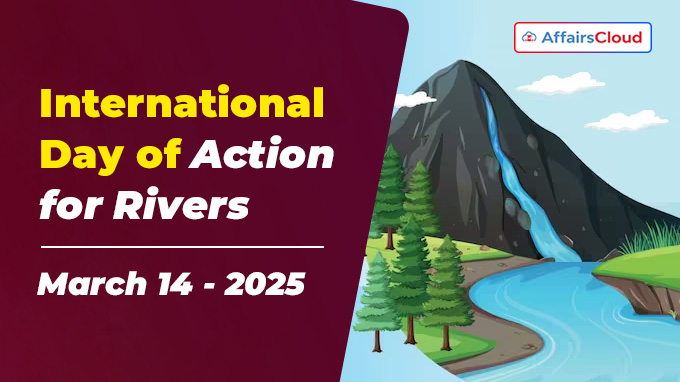 The International Day of Action for Rivers is annually observed on 14 March worldwide to raise awareness about the importance of rivers and the need to protect them. This Day highlights the significance of rivers in sustaining life and ecosystems, recognises the tireless efforts of communities that protect and restore rivers, and promotes the sustainable management of water resources.
The International Day of Action for Rivers is annually observed on 14 March worldwide to raise awareness about the importance of rivers and the need to protect them. This Day highlights the significance of rivers in sustaining life and ecosystems, recognises the tireless efforts of communities that protect and restore rivers, and promotes the sustainable management of water resources.
- 14 March 2025 marks the observance of the 28th International Day of Action for Rivers.
- The 2025 theme of the International Day of Action for Rivers is, “Our Rivers, Our Future“, which emphasises the crucial role rivers play in supporting planetary health and maintaining all life on Earth.
Note: The Day was previously known as International Day of Action Against Dams and For Rivers, Water and Life.
Background:
i.The International Day of Action Against Dams and For Rivers, Water, and Life was adopted by the participants of the 1st International Meeting of People Affected by Dams(IMPAD) in 1997 in Curitiba, Brazil.
- The idea for the 1st IMPAD originated during an annual meeting of Brazil’s Movement of People Affected by Large Dams (MAB).
ii.Representatives from 20 countries decided that the International Day of Action would take place on 14 March, coinciding with Brazil’s Day of Action Against Large Dams.
iii.The 1st International Day of Action for Rivers was observed on 14 March 1998.
Note: The 20 countries include Taiwan, Brazil, Chile, Lesotho, Argentina, Thailand, Russia, France, Switzerland, and the United States of America (USA).
Importance of Rivers:
Rivers play a vital role in:
- Providing fresh water for drinking, agriculture, and industry
- Supporting biodiversity by nurturing diverse ecosystems
- Regulating the climate and maintaining environmental balance
- Sustaining cultural traditions and livelihoods.
Threats to Rivers:
i.Pollution from industrial waste, agriculture runoff, and domestic sewage.
ii.Fragmentation due to excessive damming and infrastructure projects.
iii.Climate Change impacting water flow patterns and river ecosystems.
iv.Irresponsible Development causes habitat destruction and resource depletion
v.Deforestation and urbanisation contribute to erosion and sedimentation.
Actions to Preserve Rivers:
Communities worldwide are encouraged to:
i.Oppose water privatization initiatives and advocate for the restoration and protection of watersheds.
ii.Advocate for the removal of destructive water development projects
iii.Promote equitable and sustainable riverine development
iv.Protect and restore endangered freshwater ecosystems
Key Facts:
i.Rivers are under extreme threat, with less than 10% of the world’s river basins protected.
ii.About 115 million people still collect drinking water directly from rivers, lakes, and other surface water sources.
iii.Over millions of years, rain, rivers, and streams have washed over rocks containing the compound Sodium Chloride (NaCl) and carried it into the sea.
- Throughout the world, rivers carry an estimated 4 billion tons of dissolved salts to the ocean annually.
iv.Every day, the equivalent of 2,000 garbage trucks full of plastic are dumped into the world’s oceans, rivers, and lakes.
v.Every year 19-23 million tonnes of plastic waste leaks into aquatic ecosystems, polluting lakes, rivers, and seas.
vi.Since 1970, freshwater species populations have declined by 83%, twice the rate of decline seen in terrestrial and marine environments.
About International Rivers:
International Rivers was then called the International Rivers Network.
Co-Executive Directors– Josh Klemm, Isabella Winkler
Headquarters– California, the United States of America (USA)
Established– 1985




